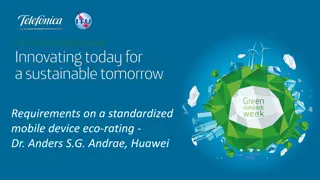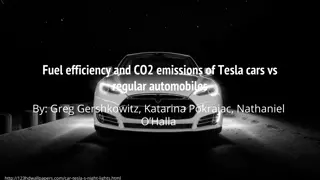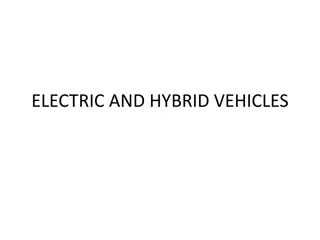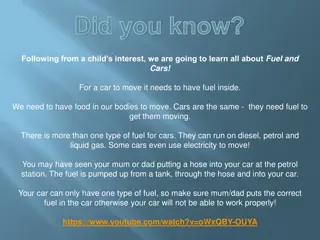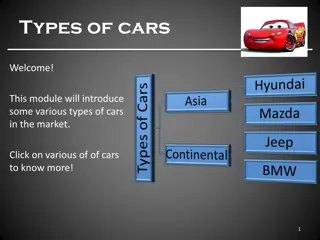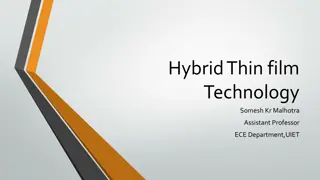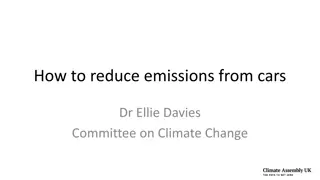
Eco-Friendly and Efficient Exploring the World of Hybrid Cars
The automotive industry is undergoing a profound transformation, driven by the urgent need to reduce carbon emissions and dependence on fossil fuels. Hybrid cars have emerged as a pivotal innovation in this landscape, offering a blend of eco-friendli
Download Presentation

Please find below an Image/Link to download the presentation.
The content on the website is provided AS IS for your information and personal use only. It may not be sold, licensed, or shared on other websites without obtaining consent from the author. Download presentation by click this link. If you encounter any issues during the download, it is possible that the publisher has removed the file from their server.
E N D
Presentation Transcript
Eco-Friendly and Efficient: Exploring the World of Hybrid Cars The automotive industry is undergoing a profound transformation, driven by the urgent need to reduce carbon emissions and dependence on fossil fuels. Hybrid cars have emerged as a pivotal innovation in this landscape, offering a blend of eco-friendliness and efficiency. These vehicles combine internal combustion engines with electric
propulsion systems, providing a sustainable alternative to traditional gasoline-powered cars. In this blog, we will delve into the world of hybrid cars, exploring their benefits, technology, market trends, and future prospects. Understanding Hybrid Cars Hybrid cars, also known as hybrids, use two or more distinct types of power sources to move the vehicle. Typically, they combine an internal combustion engine (ICE) with an electric motor. The synergy between these power sources allows hybrids to achieve superior fuel efficiency and lower emissions compared to conventional vehicles. Types of Hybrid Cars 1.Mild Hybrids: Mild hybrids use an electric motor to assist the internal combustion engine but cannot power the vehicle independently. The electric motor helps reduce the load on the engine, improving fuel efficiency and reducing emissions. 2.Full Hybrids: Full hybrids can operate using the internal combustion engine, the electric motor, or both simultaneously. They can switch between power sources or combine them, depending on driving conditions. Examples include the Toyota Prius and Ford Fusion Hybrid. 3.Plug-In Hybrids (PHEVs): PHEVs have larger battery packs that can be charged via an external power source, such as a wall outlet or charging station. This allows them to drive on electric power alone for a certain distance before the internal combustion engine kicks in. Notable examples include the Chevrolet Volt and Mitsubishi Outlander PHEV.
4.Series Hybrids: In series hybrids, the internal combustion engine does not directly drive the wheels. Instead, it generates electricity for the electric motor, which powers the vehicle. The BMW i3 with range extender is an example of a series hybrid. Benefits of Hybrid Cars Hybrid cars offer a host of benefits that make them an attractive choice for environmentally conscious consumers and those seeking to reduce their fuel expenses.
Environmental Benefits 1.Reduced Emissions: Hybrid cars produce fewer greenhouse gases and pollutants compared to conventional gasoline-powered vehicles. The electric motor reduces the reliance on the internal combustion engine, leading to lower carbon dioxide (CO2) emissions. 2.Lower Fuel Consumption: Hybrids are designed to maximize fuel efficiency. By using electric power in tandem with gasoline, they achieve higher miles per gallon (MPG) ratings, reducing the overall consumption of fossil fuels. 3.Regenerative Braking: Many hybrids feature regenerative braking systems that capture and store energy typically lost during braking. This energy is then used to recharge the battery, further enhancing efficiency. Economic Benefits 1.Fuel Savings: With their superior fuel efficiency, hybrid cars offer significant savings at the pump. This is especially beneficial for drivers with long commutes or those who frequently travel. 2.Incentives and Tax Benefits: Many governments offer incentives and tax credits for purchasing hybrid vehicles. These incentives can include rebates, reduced registration fees, and access to carpool lanes, making hybrids more affordable and practical. 3.Lower Maintenance Costs: Hybrids often experience less wear and tear on the internal combustion engine and braking systems due to the assistance of the electric motor and regenerative braking. This can result in lower maintenance and repair costs over the vehicle's lifetime. The Technology Behind Hybrid Cars
The technology that powers hybrid cars is a sophisticated blend of engineering and innovation, aimed at optimizing performance and efficiency. 1.Electric Motor and Battery: The electric motor is a crucial component of hybrid cars. It provides additional power during acceleration, reducing the load on the internal combustion engine and improving fuel efficiency. The motor is powered by a battery pack, typically made of lithium-ion or nickel-metal hydride (NiMH). These batteries are designed to be durable and efficient, with advanced management systems that ensure optimal performance and longevity. 2.Internal Combustion Engine: Hybrid cars use internal combustion engines similar to those found in traditional vehicles. However, these engines are often smaller and more efficient, as they are complemented by the electric motor. The engine can operate in various modes, including running independently, assisting the electric motor, or recharging the battery. 3.Power Control Unit: The power control unit (PCU) is the brain of the hybrid system. It manages the interaction between the electric motor, internal combustion engine, and battery. The PCU determines the most efficient power source based on driving conditions, ensuring a seamless and efficient transition between electric and gasoline power. 4.Regenerative Braking System: Regenerative braking is a key feature of hybrid cars. When the driver applies the brakes, the electric motor reverses its function, acting as a generator to convert kinetic energy into electrical energy. This energy is stored in the battery for future use, improving overall efficiency and reducing wear on the braking system.
Market Trends and Consumer Adoption The market for hybrid cars has grown significantly over the past two decades, driven by increasing environmental awareness, rising fuel costs, and supportive government policies. 1.Global Market Growth: According to recent market reports, the global hybrid car market is expected to continue its robust growth. Asia-Pacific, particularly Japan and China, leads the market in hybrid car adoption, followed by North America and Europe. Automakers are expanding their hybrid offerings, with new models entering the market each year.
2.Popular Hybrid Models: Several hybrid models have gained popularity among consumers for their reliability, efficiency, and performance. Some of the best-selling hybrids include: Toyota Prius: Often considered the pioneer of hybrid technology, the Prius remains one of the most popular hybrids worldwide. Honda Accord Hybrid: Known for its smooth ride and fuel efficiency, the Accord Hybrid is a top choice in the midsize sedan category. Ford Escape Hybrid: Combining the benefits of an SUV with hybrid efficiency, the Escape Hybrid appeals to those seeking more space and versatility. Hyundai Ioniq Hybrid: With its sleek design and advanced technology, the Ioniq Hybrid is a strong competitor in the compact hybrid market. The Future of Hybrid Cars As technology continues to advance, the future of hybrid cars looks promising. Innovations in battery technology, electric motor efficiency, and vehicle design are expected to enhance the performance and appeal of hybrids further.
1.Advancements in Battery Technology: One of the key areas of development is battery technology. Researchers are working on next-generation batteries that offer higher energy density, faster charging times, and longer lifespans. Solid-state batteries, in particular, hold significant promise for the future of hybrid and electric vehicles. 2.Integration with Renewable Energy: Hybrid cars have the potential to integrate seamlessly with renewable energy sources. As solar and wind power become more prevalent, hybrids equipped with plug-in capabilities can charge using clean energy, further reducing their environmental footprint. 3.Autonomous Driving and Connectivity: The rise of autonomous driving technology and vehicle connectivity
will also impact the hybrid car market. Autonomous hybrids can optimize power usage more effectively, while connected cars can provide real-time data on driving conditions, enabling even greater efficiency and safety. Conclusion Hybrid cars represent a significant step towards a more sustainable and efficient automotive future. By combining the best of internal combustion and electric power, hybrids offer a practical and eco-friendly solution for today's drivers. As technology continues to evolve, hybrid cars will play an increasingly important role in reducing emissions, conserving energy, and shaping the future of transportation. For consumers looking to make a positive impact on the environment while enjoying the benefits of advanced automotive technology, hybrid cars are an excellent choice. Uncover the latest trends and insights with our articles on Visionary Vogues

